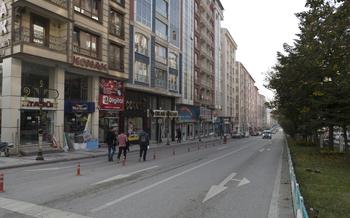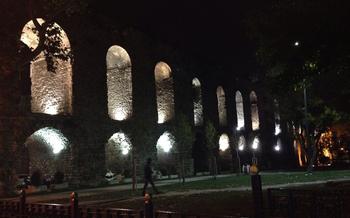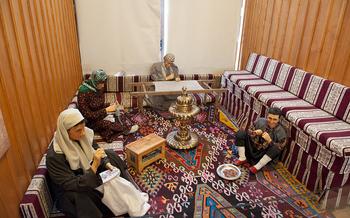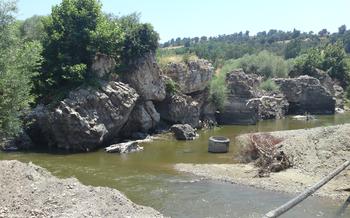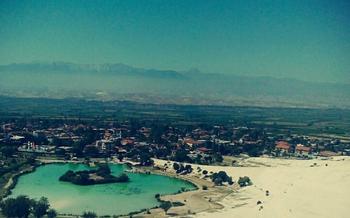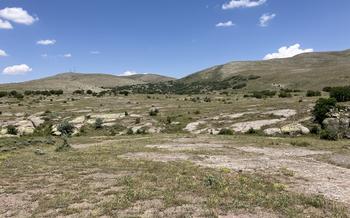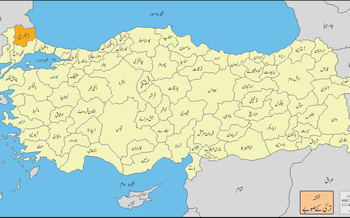
Kadirli Historical Stone Bridge
- Kadirli Historical Stone Bridge: A Timeless Masterpiece
- Location and Accessibility
- Historical Background
- Architectural Features
- Legends and Folklore
- Preservation Efforts
- Visitor Experience
- Surrounding Attractions
- Cultural Events and Festivals
- Food and Accommodation
- Planning Your Visit
- Ethical and Sustainable Tourism
- Safety and Security
- Accessibility for All
- Insider Tip: Unveiling the Hidden Gem of Kadirli
Kadirli Historical Stone Bridge: A Timeless Masterpiece
Standing as a testament to the ingenuity and craftsmanship of ancient builders, the Kadirli Historical Stone Bridge has endured centuries of use and natural disasters, serving as a vital link between communities and a symbol of the region's rich history. Constructed during the Roman period, this impressive bridge showcases intricate stonework, arched design, and carvings that speak to its architectural prowess. Woven into the fabric of local folklore, the bridge is believed to be the site of supernatural occurrences and holds a special place in the hearts of the people of Kadirli. Today, ongoing preservation efforts strive to maintain the bridge's structural integrity and historical charm, ensuring that this timeless masterpiece continues to captivate visitors for generations to come.
Location and Accessibility
The Kadirli Historical Stone Bridge is conveniently located in the heart of the city, making it easily accessible to visitors. Its exact coordinates are 37°19'7"N 36°18'46"E, allowing you to pinpoint its location on any map or navigation device. Whether you choose to explore the bridge on foot, by bike, or as part of an organized tour group, there are ample transportation options available. Public buses and taxis frequently pass near the bridge, providing easy access from various parts of the city. If you prefer the freedom of self-exploration, rental car services are readily available, offering a convenient way to reach the bridge at your own pace. Once you arrive, you'll find ample parking spaces nearby, ensuring a hassle-free visit.
Historical Background
The Kadirli Historical Stone Bridge stands as a testament to the rich history and architectural prowess of the Roman Empire. Built during their reign, it formed an integral part of the extensive Roman road network, facilitating trade, travel, and communication across the region. The bridge's strategic location allowed for efficient movement of goods and people, contributing to the economic prosperity and cultural exchange of the time.
As the centuries passed, the bridge witnessed the rise and fall of empires, adapting to the changing political and cultural landscapes. During the Byzantine period, the bridge underwent modifications and repairs, reflecting the architectural influences of this era. Later, under Ottoman rule, the bridge continued to serve as a vital link, connecting different parts of the vast Ottoman territory and facilitating trade and travel.
Throughout its existence, the bridge bore witness to countless historical events, serving as a silent observer to the dramas and triumphs that unfolded along its path. It stood resilient against the test of time, withstanding natural disasters, wars, and the ever-changing currents of history. The Kadirli Historical Stone Bridge remains a symbol of endurance and resilience, a testament to the enduring legacy of civilizations that shaped this region.
Architectural Features
The Kadirli Historical Stone Bridge stands as a testament to the engineering prowess and artistic vision of its builders. Constructed entirely of local stone, the bridge's durability is a testament to the quality of craftsmanship employed in its construction. The bridge's arched design is a marvel of engineering, allowing for water to flow freely beneath while ensuring the bridge's stability. The bridge is further adorned with intricate carvings that depict historical events and symbols, adding to its aesthetic and historical value. These carvings provide a glimpse into the culture and traditions of the people who built and used the bridge centuries ago.
Legends and Folklore
The Kadirli Historical Stone Bridge is shrouded in a rich tapestry of legends and folklore that have been passed down through generations. Local tales often weave supernatural elements into the story of its construction. One popular legend tells of a beautiful princess who vanished mysteriously, leaving behind a heartbroken prince. In his grief, he vowed to build a bridge that would reunite him with his beloved. As the story goes, the bridge was constructed with the help of supernatural beings, who worked tirelessly to complete it within a single night.
Another legend speaks of a powerful sorcerer who sought to destroy the bridge out of envy. He conjured a fierce storm, unleashing torrential rains and powerful winds. However, the bridge remained steadfast, defying the sorcerer's malevolent intentions. This tale highlights the enduring strength and resilience of the Kadirli Historical Stone Bridge, which has withstood the test of time and the forces of nature.
Beyond these fantastical tales, the bridge has also played a role in the lives of many historical figures. It is said that the great Roman general Pompey crossed the bridge during his campaigns in the region. Centuries later, the bridge served as a strategic crossing point for Ottoman armies during their conquests. These stories add to the historical significance of the Kadirli Historical Stone Bridge, making it a symbol of resilience, fortitude, and cultural heritage.
Preservation Efforts
The Kadirli Historical Stone Bridge has undergone several restoration projects over the years to maintain its structural integrity and historical charm. These efforts have involved meticulous repairs to the bridge's stonework, strengthening its foundations, and addressing any signs of wear and tear. Skilled craftsmen and experts in historical preservation have worked diligently to ensure that the bridge retains its original character while meeting modern safety standards.
In addition to restoration projects, conservation measures have been implemented to protect the bridge from weathering, vandalism, and environmental factors. Regular cleaning and maintenance are carried out to prevent the accumulation of debris and damage caused by harsh weather conditions. Visitors are encouraged to respect the bridge's historical significance and to refrain from any actions that may compromise its preservation.
Preserving the Kadirli Historical Stone Bridge is of utmost importance as it serves as a valuable historical monument that connects the past with the present. By safeguarding this architectural marvel, future generations can continue to appreciate its beauty, learn from its history, and experience the enduring legacy of the Roman Empire.
Visitor Experience
The Kadirli Historical Stone Bridge offers a serene and enchanting experience for visitors. One can stroll leisurely across the bridge, absorbing the tranquil atmosphere and admiring the surrounding scenery. The bridge provides a unique vantage point to witness the gentle flow of the river below and the lush greenery that lines its banks. Alternatively, visitors can choose to cycle across the bridge, menikmati the fresh air and the panoramic views.
The bridge is also a popular spot for photography enthusiasts. The picturesque setting, with the bridge's ancient stonework contrasting beautifully with the natural surroundings, creates a captivating subject for capturing memories. Visitors can capture stunning shots of the bridge from various angles, highlighting its architectural details or the serene landscape that envelops it.
Furthermore, the peaceful ambiance of the area makes it an ideal spot for relaxation and picnics. Visitors can spread out a blanket on the riverbank, soak in the tranquil surroundings, and enjoy a leisurely picnic. The sound of the flowing water and the gentle breeze create a soothing atmosphere, allowing visitors to unwind and rejuvenate.
Surrounding Attractions
Beyond the historical significance of the Kadirli Historical Stone Bridge, visitors can explore a variety of nearby attractions that enrich their experience in the region. Kadirli Castle, a majestic fortress dating back to the Byzantine era, stands as a testament to the area's rich history. Explore its ruins and immerse yourself in the tales of its past battles and conquests.
Discover the vibrant local culture by visiting the bustling markets near the bridge. These markets offer a unique opportunity to interact with the locals, savor delicious traditional cuisine, and find one-of-a-kind souvenirs to cherish your visit.
Nature enthusiasts can venture into the surrounding countryside to uncover hidden natural wonders. Waterfalls, caves, and scenic viewpoints await exploration, offering breathtaking panoramas and a chance to connect with the region's natural beauty.
Cultural Events and Festivals
The Kadirli Historical Stone Bridge and its surroundings come alive during various cultural events and festivals that showcase the region's rich traditions and heritage. One of the most notable events is the annual Kadirli Cherry Festival, held in June to celebrate the region's famous cherry harvest. Visitors can indulge in delicious cherry-based delicacies, participate in traditional cherry-themed games, and enjoy live music and performances.
Another popular event is the Kadirli Carpet Festival, held in September to honor the region's renowned carpet-weaving tradition. Visitors can witness skilled artisans demonstrating their craft, admire intricate carpet designs, and even purchase unique handmade carpets as souvenirs. These festivals not only provide a glimpse into the local culture but also offer a vibrant and immersive experience for visitors.
Food and Accommodation
When visiting the Kadirli Historical Stone Bridge, take the opportunity to savor the delectable flavors of traditional Turkish cuisine. The area boasts a range of restaurants and cafes that offer a culinary journey into the region's rich gastronomic heritage. Indulge in aromatic kebabs, freshly baked pide bread, and tantalizing mezes.
For an authentic experience, seek out local eateries that serve home-style dishes, using fresh, seasonal ingredients. Sample the mouthwatering yaprak sarma (stuffed vine leaves), keşkek (a hearty meat and wheat dish), or the irresistible künefe (shredded filo pastry with melted cheese and syrup).
In terms of accommodation, the area offers a range of options to suit different preferences and budgets. From charming guesthouses and boutique hotels to modern, well-equipped hotels, there's something for every traveler. Consider staying in a traditional Ottoman-style house, immersing yourself in the region's history and culture.
Remember, supporting local businesses is vital for the community's well-being. By choosing to dine and stay in local establishments, you contribute to the preservation of traditional practices and the livelihoods of the people who call this region home.
Planning Your Visit
Visiting the Kadirli Historical Stone Bridge is a unique and enriching experience that offers a glimpse into the region's rich history and cultural heritage. To make the most of your visit, careful planning is key.
When it comes to the best time to visit, the bridge's timeless beauty shines throughout the year. However, spring and fall offer particularly pleasant weather conditions, making them ideal for exploring the area. During these seasons, the surrounding landscapes are adorned with vibrant colors, creating a picturesque backdrop for your visit.
In terms of the duration of your visit, a minimum of two hours is recommended to fully appreciate the bridge's architectural details, explore its surroundings, and soak in the atmosphere. If you have additional time, consider dedicating a full day to discover the nearby attractions, such as Kadirli Castle or the local markets. This will allow you to immerse yourself in the region's culture and history, creating a truly memorable experience.
Ethical and Sustainable Tourism
As responsible travelers, it is crucial to adopt ethical and sustainable tourism practices when visiting the Kadirli Historical Stone Bridge and its surroundings. Here are some tips to ensure your visit is both enjoyable and respectful:
- Tread Lightly: Minimize your environmental impact by avoiding littering, respecting wildlife, and being mindful of noise levels.
- Support Local: Choose local restaurants, cafes, and tour operators that support the community and promote traditional practices.
- Respect the Culture: Be respectful of local customs and traditions. Dress appropriately, ask permission before taking photos, and avoid Handlungen that may be considered offensive.
- Give Back: Consider volunteering your time or making a donation to local organizations involved in preservation or community development efforts.
Safety and Security
When visiting any new destination, it's essential to prioritize safety and security. Here are some tips to ensure a safe and enjoyable experience at the Kadirli Historical Stone Bridge:
-
General Safety Tips:
-
Be aware of your surroundings and keep an eye on your belongings, especially in crowded areas.
- Avoid carrying large amounts of cash or valuables.
- Choose well-lit paths and areas when walking or cycling near the bridge, especially at night.
-
Respect local customs and traditions to avoid any misunderstandings or conflicts.
-
Emergency Contacts:
-
Keep the following emergency contact numbers handy:
- Police: 155
- Ambulance: 112
- Fire Department: 110
Remember, the local community is generally welcoming and helpful, but it's always wise to exercise caution and common sense when traveling.
Accessibility for All
The Kadirli Historical Stone Bridge embraces inclusivity, ensuring that all visitors can experience its beauty and historical significance. Accessibility features, such as ramps and handrails, have been thoughtfully incorporated to accommodate visitors with disabilities. The surrounding area is well-lit and offers ample space for wheelchairs and strollers to navigate comfortably. Furthermore, the local community is warm and welcoming, providing assistance and support to visitors with special needs, creating an inclusive environment where everyone can enjoy this remarkable landmark.
Insider Tip: Unveiling the Hidden Gem of Kadirli
Beyond the captivating allure of the Kadirli Historical Stone Bridge, a hidden gem awaits discovery. Nestled amidst nature's embrace, just a short stroll from the bridge, lies a secluded waterfall, cascading its crystal-clear waters into a tranquil pool. This enchanting spot offers a serene escape from the bustling city, inviting visitors to immerse themselves in the tranquility of nature's symphony. As you approach the waterfall, the gentle mist caresses your skin, while the melodious sounds of the cascading water soothe your senses. Take a moment to bask in the beauty of this natural wonder, breathe in the fresh air, and let your worries melt away. Whether you choose to sit by the pool and listen to the rhythmic flow of the water or capture the picturesque scene with your camera, this hidden gem is sure to leave an enduring impression.
